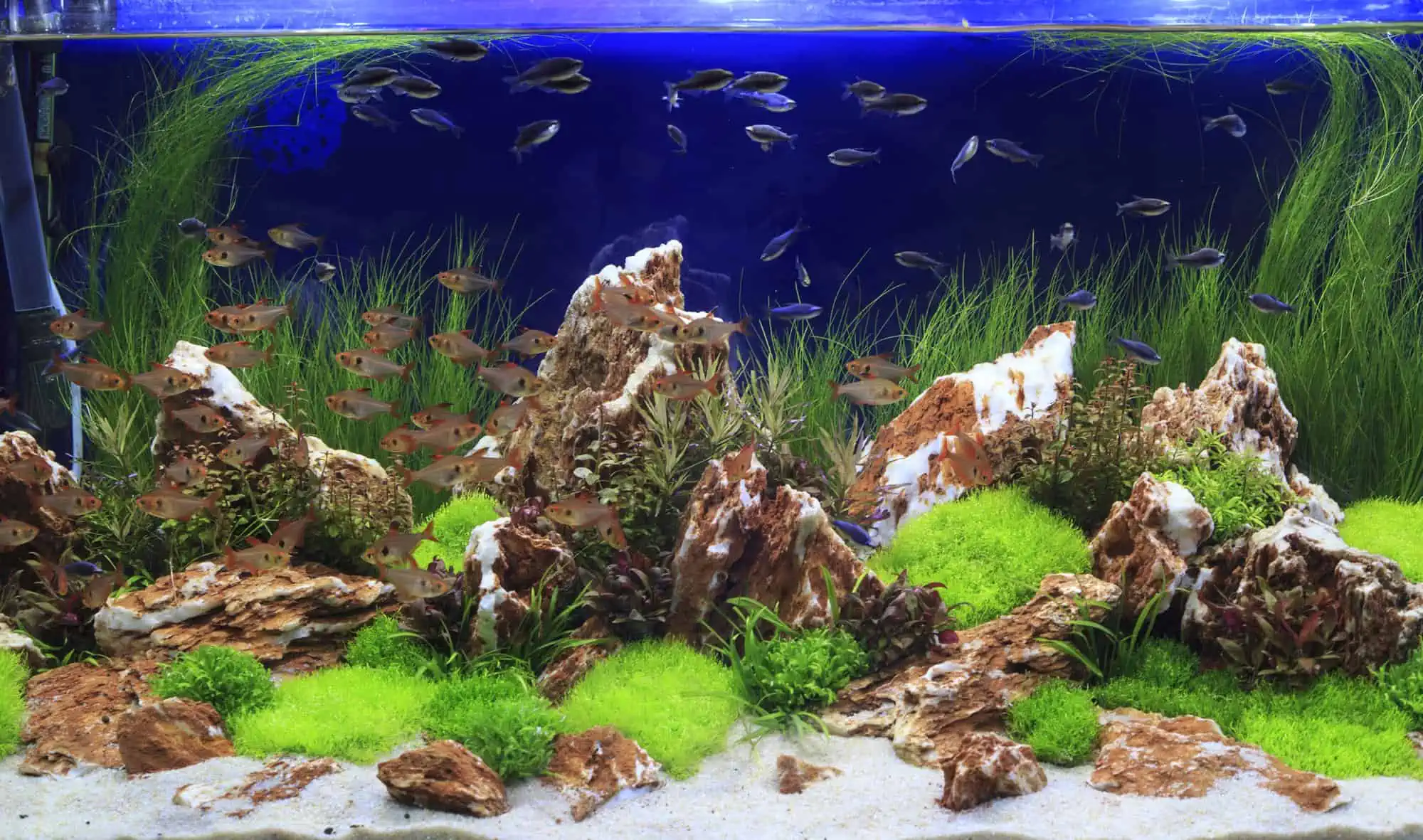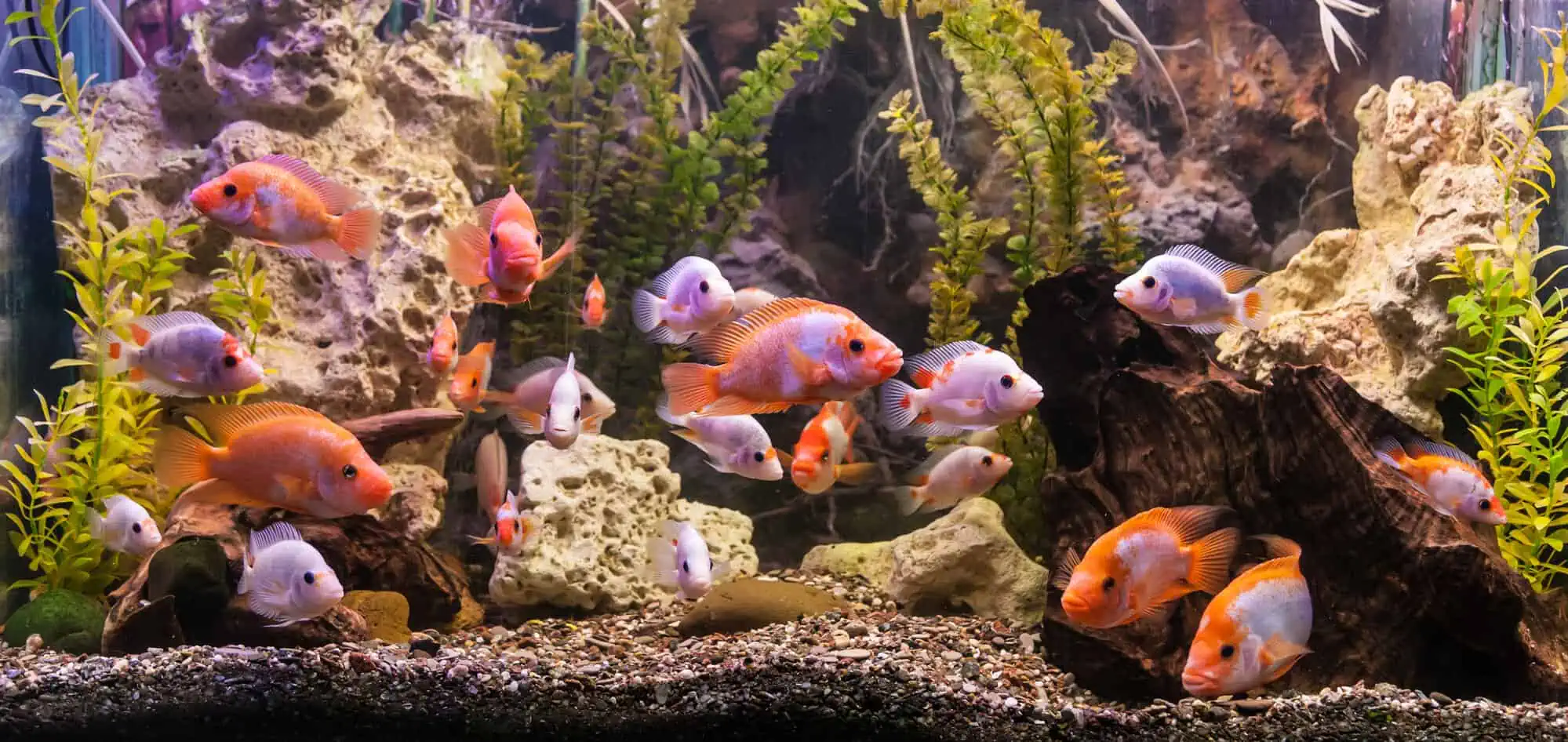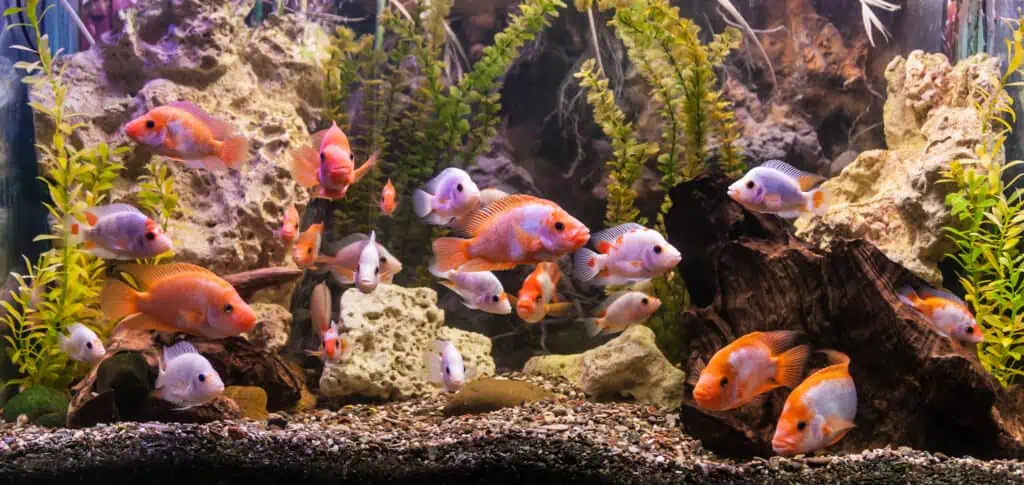Although putting a few pretty rocks and stones in your fish tank might seem like a great idea, and can make an excellent habitat for your fish, did you know that limestone can change the water chemistry?
In this article, we’re going to focus on limestone.
What happens to your fish tank water when you put a limestone rock in your tank? Is limestone harmful to your fish? Are there any benefits to adding limestone to your aquarium?
Read this guide to learn more about the pros and cons of adding limestone to your fish tank.
What Is Limestone?
Limestone or calcite aragonite is a calcareous, sedimentary rock consisting of calcium carbonate and magnesium carbonate.
Limestone is widely used in the building and decorating trade to create floor tiles and decorative features, such as fire surrounds and window sills.
In fact, I recently had a log burner installed in my home, and the fire surround is made from beautiful, honey-colored limestone.
The decorative pieces of limestone you find in pet and fish stores are inexpensive, which makes this rock a popular addition to many fish tanks.
As well as looking great, limestone leaches minerals into the fish tank water, helping to increase the pH level.
Is Limestone Harmful to Your Fish?
Although the limestone itself isn’t toxic to your fish, it can raise the pH levels in fish tank water, potentially changing the water chemistry and making it unsuitable for your fish.
So, before adding limestone to your fish tank, you need to check that the fish species you have are not super-sensitive to higher pH levels.
In addition, fluctuating pH levels are harmful to most fish, so you must check the water parameters regularly to ensure the pH is within the range your fish can tolerate.
Of course, if you have a marine or reef tank, adding limestone to the setup can be beneficial in most cases in that it raises the pH, benefiting the fish, live rocks, and corals.

Not All Limestone Is the Same
There are different types of limestone available on the market, and not all are suitable for use in fish tank water. In addition, there are some rocks offered for sale that are not actually limestone at all.
Basically, if you want to use limestone to elevate the pH levels in your aquarium, you’ll need genuine limestone.
If you’re simply looking for some attractive stones to give your setup more aesthetic appeal, it’s not so important that the rock is actually limestone.
Simple Tests
So, how can you check?
Well, there is a simple way of testing the composition of the stones you’ve chosen by using white vinegar.
Add a few drops of vinegar to the rock. If the vinegar begins foaming, you know the rock is calcareous and most likely limestone rather than marble, which can look similar.
Another easy testing method is to put the rock into a bucket of tap water.
Wait for 24 hours, and then test the water for hardness, nitrate, phosphate, and pH levels. If the alkalinity of the water increases and the acidity falls, you can be pretty confident that the rock is genuine limestone.
Limestone and Water pH Levels
Limestone has a pH level of 7.0 and can neutralize the acidity of fish tank water by reacting with the acid in the water.
That’s why many fish keepers like to keep some limestone fish tank decorations in their aquariums to balance the pH.
Limestone can also reduce excess iron levels and carbon dioxide in the water, helping to create a healthier environment for your fish.
Soft Water
If you have fish that prefer soft water, limestone can work well as an alkaline agent to neutralize the acid in the water, raise the water’s pH, and make the water harder.
What Are the Benefits of Limestone Rock for an Aquarium?
Using limestone rock in the fish tank can be beneficial for fish owners and their pets.

Aesthetically Pleasing
Many fish species thrive and look much more attractive when presented in a natural-looking habitat.
Limestone is a beautiful stone that adds natural beauty to your tank. The textured stone can also provide welcome hiding places for shy fish, nocturnal species, and fish fry.
Limestone Is Inexpensive
Authentic limestone rocks are inexpensive when compared to other tank decorations, such as dragon rock. That means you won’t need to break the bank to have your aquarium looking beautiful!
Limestone Can Prevent Algae
Because limestone is an alkaline agent, you can help to stop algae from growing by keeping some of these calcareous rocks in your aquarium water.
Limestone Works Naturally to Filter Salt
If you have a marine tank, keeping the water salinity stable and correct can be a challenge. Limestone can absorb excess amounts of salt from the water and provide natural filtration too.
Limestone Can Remove Excess Iron From the Water
Acidic water tends to carry high amounts of iron and its by-products.
In an environment where the water is heavily tainted with iron, the water often changes color and has an unpleasant odor. That’s not a good environment for your fish and doesn’t look great, either.
But placing limestone in your fish tank can lower the water pH, remove traces of iron from the water, and make the habitat healthy again.
Limestone Can Encourage Healthy Fish Growth
A small level of limestone in the water can boost the healthy growth of tropical fish. But why is limestone so good for improved fish health?
Well, limestone contains lots of minerals, including phosphorus and calcium.
Phosphorus alone is responsible for healthy hard tissue growth and development, including the growth of bone, scales, teeth, and the fish’s exoskeleton.
Can Limestone Harm My Fish?
You can see that adding a few limestone rocks to your fish tank can be great news for your fish. But can limestone harm your fish?
As you’ve learned, limestone can change the pH level in your fish tank water, which is fine as long as the variety of fish you keep can tolerate that sort of environment.
So, it’s essential that you understand your fish’s requirements and preferred water parameters before you put any limestone in your aquarium.
FAQs
In this section of our guide, we answer a few of the most commonly asked questions about using limestone in your aquarium.
Q: Will Using Limestone in a Fish Tank Increase Phosphates?
A: Rather than increasing phosphate levels in your aquarium, it’s been shown that limestone can actually reduce phosphate concentrations.
So, if you want to elevate phosphate levels in your fish tank, don’t add too much limestone.
Q: Is Limestone Toxic To Fish?
A: Adding limestone to a tank of freshwater fish should not have any ill effects on your precious fish.
Limestone itself isn’t toxic to your fish, although it can raise the pH in the aquarium, so it could make the water parameters unsuitable for some fish species.
Q: Can I Use Limestone in My Shrimp Tank?
A: Since most shrimp species enjoy slightly alkaline conditions, adding some limestone decorations to a shrimp tank should be fine in most cases.
Q: Is Limestone Good for Aquatic Plants?
A: Aquatic plants need phosphate to boost growth. Limestone has been shown to decrease phosphate levels in aquarium water, so it might be best not to use it in a planted tank.
Final Thoughts
Did you enjoy our guide to using limestone in your aquarium? If you found the information helpful, please share it before you go.
Limestone rocks and sculpted decorations can look eye-catching in your fish tank.
In addition, limestone is great for encouraging healthy fish development, removes excess iron from fish tank water, and can be used to adjust the pH level in a freshwater fish tank.
Do you use limestone to decorate your fish tank? How does that affect the water pH? Tell us in the comments box below.


